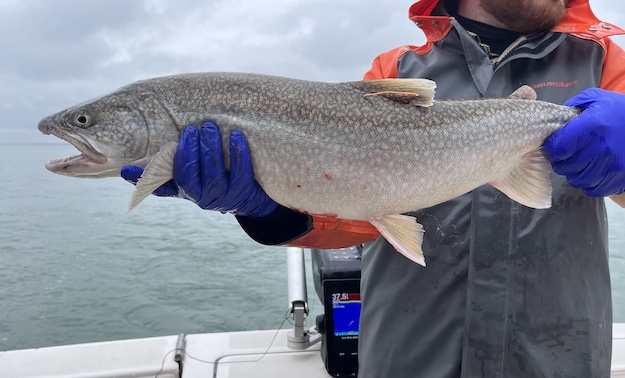US-Canada join to study migration patterns of lake trout in Lake Ontario

Photo by Jo Johnson/U.S. Fish and Wildlife Service: The orange-colored external acoustic tag, below the dorsal fin, identifies this fish as tagged in 2023. It is one of the first wild lake trout to be tagged in Lake Ontario.
Press Release, New York Sea Grant
OSWEGO – Lake trout research underway on Lake Ontario is part of the U.S.-Canada Cooperative Science and Monitoring Initiative (CSMI) field year on the lake.
Research collecting data on lake trout movement using acoustic telemetry tags is being led by the U.S. Fish and Wildlife Service (USFWS) in collaboration with the U.S. Geologic Survey (USGS), New York State Department of Environmental Conservation, Fisheries and Oceans Canada, Ontario Ministry of Natural Resources and Fisheries, with outreach assistance from New York Sea Grant (NYSG).
The tags communicate with acoustic receivers stationed on the lake bottom and collect data that will provide information about the migration patterns and habitats used by adult lake trout. This innovative technology is particularly useful for locating spawning habitats and will help to inform future restoration efforts for potentially degraded spawning sites.
More than 350 lake trout will be tagged in 2023. The tags’ battery life allows the fish to be tracked over the next ten years.
This research has already produced a “first.”
“This work in 2023 represents the first time a wild-produced lake trout has ever been tagged in Lake Ontario,” said USFWS Fish Biologist Dimitry Gorsky, Ph.D. “Lake trout are a native species that is important to the ecosystem and to the world-class sport fishery on Lake Ontario.”
The tagged fish are returned to the water to resume normal behavior to assure quality data.
New York Sea Grant is providing public outreach support to inform angling, fisheries and general public audiences about this research.
“Tagged fish that are a part of this study are marked with an external orange-colored tag,” said NYSG Great Lakes Fisheries Specialist Stacy Furgal. “If anglers catch a tagged lake trout, they can choose to return it to the water, or, if the fish is harvested, please contact Alex Gatch, agatch@usgs.gov, 607-753-9391 extension 7540, to return the internal tracking tag.”
This research is funded in part through the U.S. Environmental Protection Agency Great Lakes Restoration Initiative.









































































